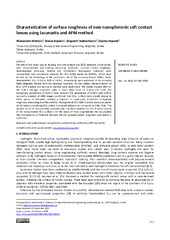Приказ основних података о документу
Characterization of surface roughness of new nanophotonic soft contact lenses using lacunarity and AFM method
| dc.creator | Mitrović, Aleksandra | |
| dc.creator | Bojović, Božica | |
| dc.creator | Stamenković, Dragomir | |
| dc.creator | Popović, Dejana | |
| dc.date.accessioned | 2022-09-19T18:25:51Z | |
| dc.date.available | 2022-09-19T18:25:51Z | |
| dc.date.issued | 2018 | |
| dc.identifier.issn | 0367-598X | |
| dc.identifier.uri | https://machinery.mas.bg.ac.rs/handle/123456789/2797 | |
| dc.description.abstract | The aim of this study was to develop new soft contact lens (SCL) materials which would, after recommended and existing machining processes, improve surface roughness. Nanomaterials (fullerene, fullerol and methformin hydroxylate fullerene) were incorporated into commercial material for SCL (SL38) based on PHEMA, which were derived by the technology in the production lab of the company Soleko (Milan, Italy). Nanophotonic SCLs (SL38-A, SL38-B, SL38-C, respectively) were produced in the company Optix (Belgrade, Serbia) from the obtained materials. For the surface characterization of SCLs, AFM analysis and lacunarity method were performed. The results showed that for the SL38-B average roughness value is lower than those of SL38-A and SL38. The topography parameters of SL38-C were between the parameters of SL38-A and SL38-B. Lacunarity analysis of AFM images confirmed that SCLs surface state should belong to either group of adequate (slanted p-diagram) or inadequate (contorted p-diagram) roughness concerning tear film stability. Nanophotonic SCL SL38-C exibits more acceptable performance considering SCL surface functional behavior as compared to other SCLs. The positive result of incorporating nanomaterials into basic material for SCL is better quality of the nanophotonic SCLs surfaces. On the bases of these experiments, the assumption that incorporation of fullerene derivate will not increase surface roughness parameters is confirmed. | en |
| dc.publisher | Savez hemijskih inženjera, Beograd | |
| dc.relation | info:eu-repo/grantAgreement/MESTD/Integrated and Interdisciplinary Research (IIR or III)/45009/RS// | |
| dc.rights | openAccess | |
| dc.rights.uri | https://creativecommons.org/licenses/by-nc-nd/4.0/ | |
| dc.source | Hemijska Industrija | |
| dc.subject | soft contact lenses | en |
| dc.subject | nanophotonic contact lenses | en |
| dc.subject | lacunarity | en |
| dc.subject | fullerenes | en |
| dc.subject | AFM | en |
| dc.title | Characterization of surface roughness of new nanophotonic soft contact lenses using lacunarity and AFM method | en |
| dc.type | article | |
| dc.rights.license | BY-NC-ND | |
| dc.citation.epage | 166 | |
| dc.citation.issue | 3 | |
| dc.citation.other | 72(3): 157-166 | |
| dc.citation.rank | M23 | |
| dc.citation.spage | 157 | |
| dc.citation.volume | 72 | |
| dc.identifier.doi | 10.2298/HEMIND170924004M | |
| dc.identifier.fulltext | http://machinery.mas.bg.ac.rs/bitstream/id/1494/2794.pdf | |
| dc.identifier.scopus | 2-s2.0-85048467543 | |
| dc.identifier.wos | 000434656400005 | |
| dc.type.version | publishedVersion |


